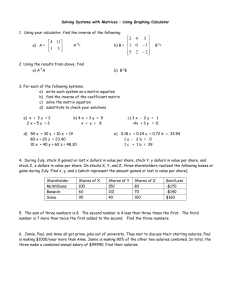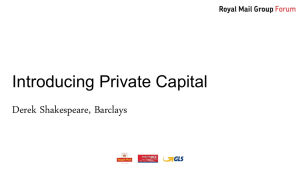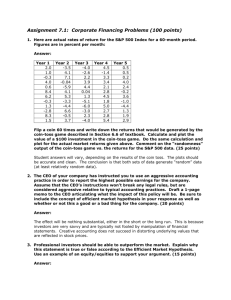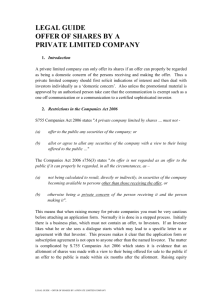BEM 103: Introduction to Finance. Homework 3: Markets and efficiency
advertisement
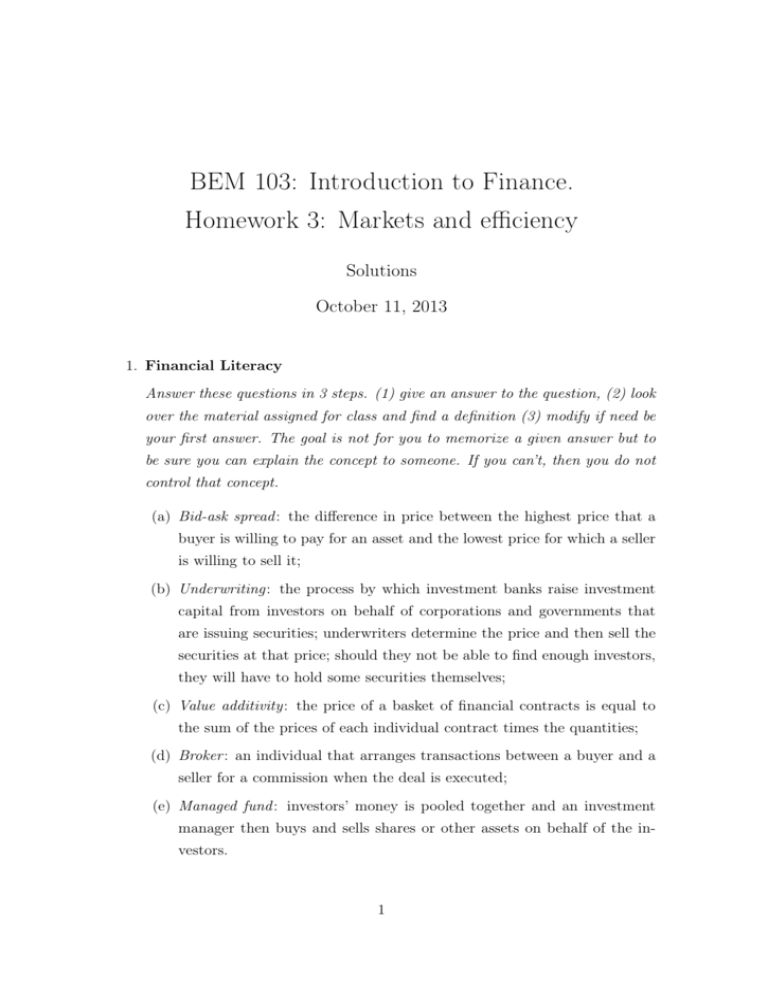
BEM 103: Introduction to Finance. Homework 3: Markets and efficiency Solutions October 11, 2013 1. Financial Literacy Answer these questions in 3 steps. (1) give an answer to the question, (2) look over the material assigned for class and find a definition (3) modify if need be your first answer. The goal is not for you to memorize a given answer but to be sure you can explain the concept to someone. If you can’t, then you do not control that concept. (a) Bid-ask spread : the difference in price between the highest price that a buyer is willing to pay for an asset and the lowest price for which a seller is willing to sell it; (b) Underwriting: the process by which investment banks raise investment capital from investors on behalf of corporations and governments that are issuing securities; underwriters determine the price and then sell the securities at that price; should they not be able to find enough investors, they will have to hold some securities themselves; (c) Value additivity: the price of a basket of financial contracts is equal to the sum of the prices of each individual contract times the quantities; (d) Broker : an individual that arranges transactions between a buyer and a seller for a commission when the deal is executed; (e) Managed fund : investors’ money is pooled together and an investment manager then buys and sells shares or other assets on behalf of the investors. 1 (f) Double auction: the market where buyers and sellers call out prices that they are willing to buy and sell at, and a match is made if a buyer and seller call out the same price (bids tend to increase and offers tend to decrease until one of the bids or offers is accepted). 2. Closed end funds The Templeton Dragon fund is a closed end fund. Its last transaction was $26.7, its net asset value at the same time was $29.9. It has 38 million shares outstanding and the order book at 9:20 am is shown in the table below. And the monthly volume of trade is 60K shares a day. Bid Ask Price Size Price Size 25.71 100 26.85 100 24.65 100 26.88 100 23.85 100 26.95 100 19.12 200 26.98 100 (a) Does this empirical evidence suggest that following axiom fails? i. Value additivity, ii. Financial markets are competitive, iii. Markets are efficient. Explain your choice, you may argue for a combination of these answers. Value additivity is violated as assets less the value of its liabilities =$29.9>$26.7=market NAV= the value of fund’s number of shares outstanding price. As for the second axiom (financial markets are competitive and therefore the price is taken as given by all participants), it is not unarguably true here since the bid-ask spread is relatively big and the demand curve is steep. There is no evidence of violation of the efficiency axiom. (b) Why would anyone want to invest in this fund? (if they do not what is their alternative?) 2 If we believe in the efficiency market axiom there should be a reason why market prices the fund that way. So, there is no reason to think that the price will go up to NAV. However, if you really think so, you might want to buy the stocks and wait until you prediction comes true (if it does...). Another reason might be the following. If you have a small amount of wealth, investing in the fund gives you both diversification and liquidity. If you are rich, however, you can do better by investing directly in a portfolio of funds. (c) Suggest a way to extrapolate from the order book to compute the supply curve of shares and make a guess as to how many shares you could buy for a price less than the NAV. Would that allow you to gain control of the fund? One way to extrapolate from the order book is 26.85 + 0.1 · # of shares , 200 price(# of shares) = 26.88 + 0.1 · # of shares−100 , 200 if # of shares = 200n if # of shares = 200n − 100 where the number of shares is a multiple of 100. So, NAV = 29.9 > 29.88 = 26.88 + 0.1 · 30 which means you can buy 30 · 200 + 100 = 6100 which is less than 19 millions of shares that would give you control of the fund. 3. Taxes and Modigliani Miller CITinc.com is a well established firm it has a market capitalization of 5 billion dollars, 1.2 billion dollars in debt outstanding, a line of credit at the Bank of Pasadena of 400 million dollars that it has not yet used, and a cash reserve of 150 million dollars. It pays 200 million dollars in dividends, the 1 year rate of interest is 4%. On January 1 the head of R&D comes to the CEO and announce that she has a terrific product that will cost 100 million to bring to market by Christmas season and expected profits before capital costs are 110 million dollars next Christmas season. (a) Should the CEO agree to undertake the project? Yes. 3 The net present value of this project is −100m + 110m ≈ 1.7m > 0 1.042 (b) The CEO can issue 100 million dollars in new stock, draw on the credit line, or from cash reserves. The interest at which the firm borrows is the same as what the firm receives for its reserves. What choice is best? According to Modigliani Miller theorem1 , the CEO should be indifferent. (c) If it issues new stock it must do so all at once (on January 2), if it uses its cash reserves or draws on its credit line, the firm only starts to pay interest when it draws the money (in thirds on March 1, May 1, and September 1). Does that alter the choice above? Why? Again, the CEO should be indifferent (as he can put unused money to a bank and get the interest 4%). (d) Now consider the fact that if the firm does not pay taxes on interest but faces a 20% tax on dividends paid out. What is the best financial strategy for the firm to follow? It is better to use either cash reserves or credit line. 4. UPC On 1/10/85, the following announcement was made: “Early today the Justice Department reached a decision in the UPC case. UPC has been found guilty of discriminatory practices in hiring. For the next five years, UPC must pay $2 million each year to a fund representing victims of UPC policies.” (a) Should investors not buy UPC stock after the announcement because the litigation will cause an abnormally low rate of return over the next five years? Investors should be indifferent because the price after the announcement will immediately fall to take into account the full future cost of the penalties. (b) Would the amount of debt that the firm carries change your mind? No because the price is fair in efficient markets, that is it correctly aggregates all available information including the amount of debt. 1 Modigliani Miller theorem holds as the interest rates for stock capital and for bond capital are the same (4% = 200m 5b ). 4 5. Efficient Markets Hypothesis “The Japanese economy has deep structural problems, which the Japanese seem reluctant to overcome. We do not see any major change in this situation over the next two to three years. Hence, we advise against investing in the Tokyo stock market, because we expect returns to be below average for the next two to three years.” Does the statement above make sense in view of the Efficient Markets Hypothesis? No. According to the Efficient Markets Hypothesis, all prices always reflect all available information and they are the best forecast of future returns. So, if returns are expected to be low, prices should also be low. 6. Facebook Return to the slide for Class 4. Based on the data you see there and what you can glean from the web, was Facebook overpriced at $38 when it was first issued? Why? Yes because the price went down very quickly. The demand was very high as people were overoptimistic about another technology company after recent popular IPO of Google and LinkedIn. So, the primary IPO underwriter Morgan Stanley raised the price up to $38 and moreover Facebook announced that it would sell 25% more shares than originally planned due to high demand. In other words, if markets are efficient then the rise in price in recent months reflect new information about the future profits of Facebook, so it does not provide information about the correct price at IPO because the course of events since is only one of the possible outcomes. 5


